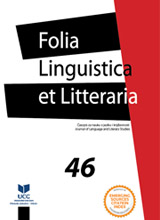KULTURNA DISKREPANCA U PREVODU SRPSKE KULTURNO SPECIFIČNE LEKSIKE NA NEMAČKI JEZIK U DIJALOGU SRBINA I NEMCA NA DUNAVU Š. BARTA I N. N. STEFANOVIĆA: TRAGOVI NARODA
CULTURAL GAP IN GERMAN TRANSLATION OF SERBIAN CULTURAL-SPECIFIC LEXIS IN S. BARTH’S AND N. N. STEFANOVIĆ’S DIALOGUE ON THE DANUBE. CONVERSATIONS BETWEEN A SERB AND A GERMAN: THE TRACES OF THE NATIONS
Author(s): Jovana N. RanđelovićSubject(s): Lexis, Comparative Linguistics, Western Slavic Languages, Translation Studies
Published by: Filološki fakultet, Nikšić
Keywords: cultural studies; cultural categories; Serbian cultural-specific lexis; cultural gap;
Summary/Abstract: The aim of this paper is to present one of the possible methodological approaches to analysing culturally valuable linguistic phenomena. Since cultural studies has been one of the fastest expanding scientific fields over the last decades, one might argue that the element of culture has been “the thing missing”, one which could further contribute to our ever-lasting urge to understand our language, our literature and ultimately ourselves. The work of Anna Wierzbicka is certainly one which most obviously contributes to a linguistic understanding of the relationship between culture and language. Among the Serbian linguists, we should mention Bugarski’s Jezik i kultura (Eng. Language and Culture). In both of their works, there is an underlying consideration of cultural influence on the development of language and identity. This study, however, although taking into consideration different approaches to analysing culturally-loaded linguistic phenomena, was based mainly on semiotic terms. Despite the fact that there is a hypothesized cultural influence on the development of language as a system (i.e. grammar, syntactic structures, and so on) these were not taken into consideration and the main focus remained at the level of “meaning”. The analysed data stems from the first chapter of Barth´s and Stefanović’s Dijalog Srbina i Nemca na Dunavu called Tragovi naroda and its German translation Dialog an der Donau: Gespräche zwischen einem Serben und einem Deutschen – Die Spuren der Völker. The main goal of the data extraction process was to identify the cultural gap i.e. those lexical items (single words, phrases, or even clauses) which could be seen as culturally-loaded and categorized into cultural categories. The latter term, originally coined and developed by Nida, was then adapted by Newmark. In his adaptation, there are five cultural categories: ecology; material culture; social culture; organizations, customs, activities, procedures, concepts and gestures and habits, each of them explained in his Textbook of Translation. The main difference to Nidas concepts lies in excluding linguistic culture, which turned out to be one of the rather useful categories to consider when analysing this type of data. Having recognized this and also the fact that cultural categories are in no instance to be understood as absolutes, this research uses Newmark’s adaptation as its starting point and develops it further. Categories such ecology and material culture, even the ones concerning social and organizational aspects of a specific community, might thus be viewed as relatively “stable” in the matter of what they are referring themselves to − although it could be argued that sometimes overlaps can be found. Gestures and habits, on the other hand, are not as clearly defined, which might be due to their rather abstract nature. One of the possible ways to further explain them is to include the previously excluded linguistic culture, as it is highly connected to the process of communication and (non-)verbal behaviours. Using Serbian and German dictionaries, all 22 culturally-loaded lexical items were then analysed. This approach enabled a precised identification of the particular dimensions which actually contributed to the cultural gap. Some of them were etymological in their nature:for example, divaniti, fruštuk, or našte, while some were idiomatic: suvo, gorostasan, napustiti ognjište, some religous: pokrov, or sablasno, and some proved themselves to be completely untranslatable: stenlejka, madžarka, and čačanska rana, for example. Certain historical aspects of Serbian culture also played a significant role which could be seen in examples such as fruštuk, divaniti, štempla, karan, ceh, cimerung, and kverung. The borrowed lexical items could be directly translated into German, but they also have their equivalents in Serbian. The cultural gap was to be found in discovering the impact that German and Turkish language had on Serbian. The last category, gestures and habits, proved itself to be rather dependent on the subcategory linguistic culture, as it included only one item, divaniti, which could be seen as a specific, culturally-loaded means of verbal expression.
Journal: Folia Linguistica et Litteraria
- Issue Year: 2023
- Issue No: 46
- Page Range: 7-26
- Page Count: 20
- Language: Serbian

